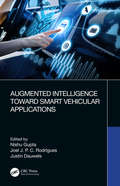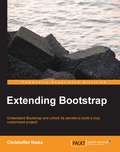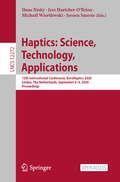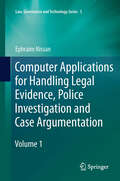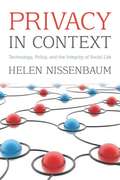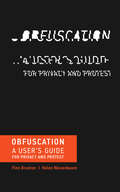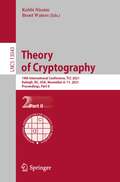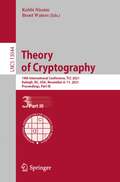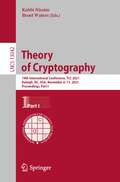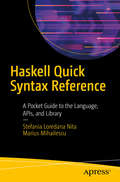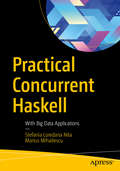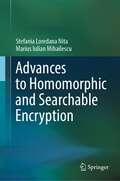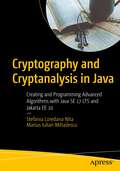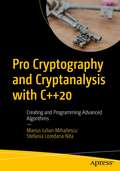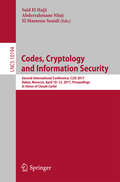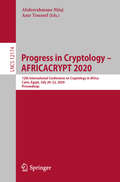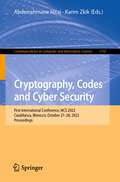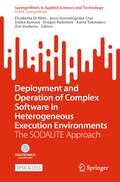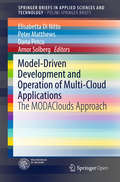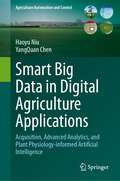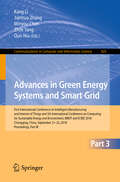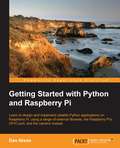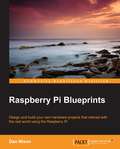- Table View
- List View
Augmented Intelligence Toward Smart Vehicular Applications
by Nishu Gupta, Joel J. P. C. Rodrigues, and Justin DauwelsThis up-to-date reference text discusses important concepts of vehicular communication in intelligent transportation systems. The text begins by discussing the key objectives of intelligent transport systems and Vehicular ad-hoc networks (VANETs). It then goes on to discuss challenges, applications, and future trends in Vehicular ad-hoc networks. The text focuses on the organization of Artificial Intelligence (AI) and aspects of deep learning algorithms, particularly multimodal transport. The text will serve as an ideal reference for graduate students and academic researchers in the field of electrical engineering, electronics and communication engineering, and transportation engineering.
Extending Bootstrap
by Christoffer NiskaPractical and instruction-based, this concise book will take you from understanding what Bootstrap is, to creating your own Bootstrap theme in no time! If you are an intermediate front-end developer or designer who wants to learn the secrets of Bootstrap, this book is perfect for you.
Haptics: 12th International Conference, EuroHaptics 2020, Leiden, The Netherlands, September 6–9, 2020, Proceedings (Lecture Notes in Computer Science #12272)
by Ilana Nisky Jess Hartcher-O’Brien Michaël Wiertlewski Jeroen SmeetsThis open access book constitutes the proceedings of the 12th International Conference on Human Haptic Sensing and Touch Enabled Computer Applications, EuroHaptics 2020, held in Leiden, The Netherlands, in September 2020. The 60 papers presented in this volume were carefully reviewed and selected from 111 submissions. The were organized in topical sections on haptic science, haptic technology, and haptic applications. This year's focus is on accessibility.
Computer Applications for Handling Legal Evidence, Police Investigation and Case Argumentation (Law, Governance and Technology Series #5)
by Ephraim NissanThis book provides an overview of computer techniques and tools -- especially from artificial intelligence (AI) -- for handling legal evidence, police intelligence, crime analysis or detection, and forensic testing, with a sustained discussion of methods for the modelling of reasoning and forming an opinion about the evidence, methods for the modelling of argumentation, and computational approaches to dealing with legal, or any, narratives. By the 2000s, the modelling of reasoning on legal evidence has emerged as a significant area within the well-established field of AI & Law. An overview such as this one has never been attempted before. It offers a panoramic view of topics, techniques and tools. It is more than a survey, as topic after topic, the reader can get a closer view of approaches and techniques. One aim is to introduce practitioners of AI to the modelling legal evidence. Another aim is to introduce legal professionals, as well as the more technically oriented among law enforcement professionals, or researchers in police science, to information technology resources from which their own respective field stands to benefit. Computer scientists must not blunder into design choices resulting in tools objectionable for legal professionals, so it is important to be aware of ongoing controversies. A survey is provided of argumentation tools or methods for reasoning about the evidence. Another class of tools considered here is intended to assist in organisational aspects of managing of the evidence. Moreover, tools appropriate for crime detection, intelligence, and investigation include tools based on link analysis and data mining. Concepts and techniques are introduced, along with case studies. So are areas in the forensic sciences. Special chapters are devoted to VIRTOPSY (a procedure for legal medicine) and FLINTS (a tool for the police). This is both an introductory book (possibly a textbook), and a reference for specialists from various quarters.
FutureShop: How to Trade Up to a Luxury Lifestyle Today
by Daniel NissanoffThis is a book about change. In particular, it's about how our consumer culture is rapidly evolving to allow us to live better, richer lives for less. The catalyst to this change is eBay and similar sites that are quickly growing into mainstream shopping venues and creating unprecedented levels of liquidity for our everyday goods. The wave of the future will be temporary ownership-consumers will be able to buy what they really want because they'll be able to easily sell it when they are ready to upgrade to the next item on their wish list. Veteran Web entrepreneur Daniel Nissanoff's invaluable heads-up explores why this change is taking place and discusses what consumers and businesses can do in order to benefit from this new paradigm.
Privacy in Context
by Helen NissenbaumPrivacy is one of the most urgent issues associated with information technology and digital media. This book claims that what people really care about when they complain and protest that privacy has been violated is not the act of sharing information itself-most people understand that this is crucial to social life -but the inappropriate, improper sharing of information. Arguing that privacy concerns should not be limited solely to concern about control over personal information, Helen Nissenbaum counters that information ought to be distributed and protected according to norms governing distinct social contexts-whether it be workplace, health care, schools, or among family and friends. She warns that basic distinctions between public and private, informing many current privacy policies, in fact obscure more than they clarify. In truth, contemporary information systems should alarm us only when they function without regard for social norms and values, and thereby weaken the fabric of social life.
Obfuscation: A User's Guide for Privacy and Protest (The\mit Press Ser.)
by Helen Nissenbaum Finn BruntonHow we can evade, protest, and sabotage today's pervasive digital surveillance by deploying more data, not less—and why we should.With Obfuscation, Finn Brunton and Helen Nissenbaum mean to start a revolution. They are calling us not to the barricades but to our computers, offering us ways to fight today's pervasive digital surveillance—the collection of our data by governments, corporations, advertisers, and hackers. To the toolkit of privacy protecting techniques and projects, they propose adding obfuscation: the deliberate use of ambiguous, confusing, or misleading information to interfere with surveillance and data collection projects. Brunton and Nissenbaum provide tools and a rationale for evasion, noncompliance, refusal, even sabotage—especially for average users, those of us not in a position to opt out or exert control over data about ourselves. Obfuscation will teach users to push back, software developers to keep their user data safe, and policy makers to gather data without misusing it.Brunton and Nissenbaum present a guide to the forms and formats that obfuscation has taken and explain how to craft its implementation to suit the goal and the adversary. They describe a series of historical and contemporary examples, including radar chaff deployed by World War II pilots, Twitter bots that hobbled the social media strategy of popular protest movements, and software that can camouflage users' search queries and stymie online advertising. They go on to consider obfuscation in more general terms, discussing why obfuscation is necessary, whether it is justified, how it works, and how it can be integrated with other privacy practices and technologies.
Theory of Cryptography: 19th International Conference, TCC 2021, Raleigh, NC, USA, November 8–11, 2021, Proceedings, Part II (Lecture Notes in Computer Science #13043)
by Kobbi Nissim Brent WatersThe three-volume set LNCS 13042, LNCS 13043 and LNCS 13044 constitutes the refereed proceedings of the 19th International Conference on Theory of Cryptography, TCC 2021, held in Raleigh, NC, USA, in November 2021. The total of 66 full papers presented in this three-volume set was carefully reviewed and selected from 161 submissions. They cover topics on proof systems, attribute-based and functional encryption, obfuscation, key management and secure communication.
Theory of Cryptography: 19th International Conference, TCC 2021, Raleigh, NC, USA, November 8–11, 2021, Proceedings, Part III (Lecture Notes in Computer Science #13044)
by Kobbi Nissim Brent WatersThe three-volume set LNCS 13042, LNCS 13043 and LNCS 13044 constitutes the refereed proceedings of the 19th International Conference on Theory of Cryptography, TCC 2021, held in Raleigh, NC, USA, in November 2021. The total of 66 full papers presented in this three-volume set was carefully reviewed and selected from 161 submissions. They cover topics on proof systems, attribute-based and functional encryption, obfuscation, key management and secure communication.
Theory of Cryptography: 19th International Conference, TCC 2021, Raleigh, NC, USA, November 8–11, 2021, Proceedings, Part I (Lecture Notes in Computer Science #13042)
by Kobbi Nissim Brent WatersThe three-volume set LNCS 13042, LNCS 13043 and LNCS 13044 constitutes the refereed proceedings of the 19th International Conference on Theory of Cryptography, TCC 2021, held in Raleigh, NC, USA, in November 2021. The total of 66 full papers presented in this three-volume set was carefully reviewed and selected from 161 submissions. They cover topics on proof systems, attribute-based and functional encryption, obfuscation, key management and secure communication.
Haskell Quick Syntax Reference: A Pocket Guide to the Language, APIs, and Library
by Stefania Loredana Nita Marius MihailescuThis condensed code and syntax reference presents the essential Haskell syntax in a well-organized format that can be used as a quick and handy reference, including applications to cloud computing and data analysis. This book covers the functional programming features of Haskell as well as strong static typing, lazy evaluation, extensive parallelism, and concurrency You won’t find any technical jargon, bloated samples, drawn out history lessons, or witty stories in this book. What you will find is a language reference that is concise, to the point and highly accessible. The Haskell Quick Syntax Reference is packed with useful information and is a must-have for any Haskell programmer working in big data, data science, and cloud computing.What You Will LearnQuickly and effectively use the Haskell programming languageTake advantage of strong static typingWork with lazy evaluations Harness concurrency and extensive parallelism using HaskellWho This Book Is ForExperienced programmers who may be new to Haskell or have experience with Haskell and who just want a quick reference guide on it.
Practical Concurrent Haskell
by Stefania Loredana Nita Marius MihailescuLearn to use the APIs and frameworks for parallel and concurrent applications in Haskell. This book will show you how to exploit multicore processors with the help of parallelism in order to increase the performance of your applications. Practical Concurrent Haskell teaches you how concurrency enables you to write programs using threads for multiple interactions. After accomplishing this, you will be ready to make your move into application development and portability with applications in cloud computing and big data. You'll use MapReduce and other, similar big data tools as part of your Haskell big data applications development. What You'll Learn Program with Haskell Harness concurrency to Haskell Apply Haskell to big data and cloud computing applications Use Haskell concurrency design patterns in big data Accomplish iterative data processing on big data using Haskell Use MapReduce and work with Haskell on large clusters Who This Book Is For Those with at least some prior experience with Haskell and some prior experience with big data in another programming language such as Java, C#, Python, or C++.
Advances to Homomorphic and Searchable Encryption
by Stefania Loredana Nita Marius Iulian MihailescuThis book presents the current state of the literature on the fields of homomorphic and searchable encryption, from both theoretical and practical points of view. Homomorphic and searchable encryption are still relatively novel and rapidly evolving areas and face practical constraints in the contexts of large-scale cloud computing and big data.Both encryption methods can be quantum-resistant if they use the right mathematical techniques. In fact, many fully homomorphic encryption schemes already use quantum-resistant techniques, such as lattices or characteristics of polynomials – which is what motivated the authors to present them in detail.On the one hand, the book highlights the characteristics of each type of encryption, including methods, security elements, security requirements, and the main types of attacks that can occur. On the other, it includes practical cases and addresses aspects like performance, limitations, etc. As cloud computing and big data already represent the future in terms of storing, managing, analyzing, and processing data, these processes need to be made as secure as possible, and homomorphic and searchable encryption hold huge potential to secure both the data involved and the processes through which it passes.This book is intended for graduates, professionals and researchers alike. Homomorphic and searchable encryption involve advanced mathematical techniques; accordingly, readers should have a basic background in number theory, abstract algebra, lattice theory, and polynomial algebra.
Cryptography and Cryptanalysis in Java: Creating and Programming Advanced Algorithms with Java SE 17 LTS and Jakarta EE 10
by Stefania Loredana Nita Marius Iulian MihailescuHere is your in-depth guide to cryptography and cryptanalysis in Java. This book includes challenging cryptographic solutions that are implemented in Java 17 and Jakarta EE 10. It provides a robust introduction to Java 17's new features and updates, a roadmap for Jakarta EE 10 security mechanisms, a unique presentation of the "hot points" (advantages and disadvantages) from the Java Cryptography Architecture (JCA), and more. The book dives into the classical simple cryptosystems that form the basis of modern cryptography, with fully working solutions (encryption/decryption operations). Pseudo-random generators are discussed as well as real-life implementations. Hash functions are covered along with practical cryptanalysis methods and attacks, asymmetric and symmetric encryption systems, signature and identification schemes. The book wraps up with a presentation of lattice-based cryptography and the NTRU framework library. Modern encryption schemes for cloud and big data environments (homomorphic encryption and searchable encryption) also are included. After reading and using this book, you will be proficient with crypto algorithms and know how to apply them to problems you may encounter. What You Will Learn Develop programming skills for writing cryptography algorithms in Java Dive into security schemes and modules using Java Explore “good” vs “bad” cryptography based on processing execution times and reliability Play with pseudo-random generators, hash functions, etc. Leverage lattice-based cryptography methods, the NTRU framework library, and more Who This Book Is For Those who want to learn and leverage cryptography and cryptanalysis using Java. Some prior Java and/or algorithm programming exposure is highly recommended.
Pro Cryptography and Cryptanalysis with C++20: Creating and Programming Advanced Algorithms
by Stefania Loredana Nita Marius Iulian MihailescuDevelop strong skills and a passion for writing cryptography algorithms and security schemes/modules using C++ 20 and its new features. You will find the right methods of writing advanced cryptographic algorithms (such as, elliptic curve cryptography algorithms, lattice-based cryptography, searchable encryption, and homomorphic encryption), examine internal cryptographic mechanisms, and discover common ways in which the algorithms could be implemented and used correctly in practice. The authors avoid the complexities of the mathematical background by explaining its mathematical basis in terms that a programmer can easily understand. They show how “bad” cryptography creeps in during implementation and what “good” cryptography should look like. They do so by showing and comparing the advantages and disadvantages based on processing time, execution time, and reliability. What You Will Learn Understand where and why cryptography is used and how it gets misused Discover what modern cryptography algorithms and methods are used for Design and implement advanced cryptographic mechanisms See how C++20 and its new features are impacting the future of implementing cryptographic algorithms Practice the basics of public key cryptography, including ECDSA signatures and more Find out how most of the algorithms can be broken Who This Book Is For Professional programmers, developers, and software engineers who are developing cryptography algorithms and security schemes/modules in C++. Prior C++ programming and IDE experience and some basic experience of cryptography concepts (symmetric and asymmetric) highly recommended.
Codes, Cryptology and Information Security: Second International Conference, C2SI 2017, Rabat, Morocco, April 10–12, 2017, Proceedings - In Honor of Claude Carlet (Lecture Notes in Computer Science #10194)
by Abderrahmane Nitaj Said El Hajji El Mamoun SouidiThis book constitutes the proceedings of the First International Conference on Codes, Cryptology and Information Security, C2SI 2015, held in Rabat, Morocco, in May 2015. The 22 regular papers presented together with 8 invited talks were carefully reviewed and selected from 59 submissions. The first aim of this conference is to pay homage to Thierry Berger for his valuable contribution in teaching and disseminating knowledge in coding theory and cryptography in Morocco since 2003. The second aim of the conference is to provide an international forum for researchers from academia and practitioners from industry from all over the world for discussion of all forms of cryptology, coding theory and information security.
Progress in Cryptology - AFRICACRYPT 2020: 12th International Conference on Cryptology in Africa, Cairo, Egypt, July 20 – 22, 2020, Proceedings (Lecture Notes in Computer Science #12174)
by Abderrahmane Nitaj Amr YoussefThis book constitutes the refereed proceedings of the 12th International Conference on the Theory and Application of Cryptographic Techniques in Africa, AFRICACRYPT 2020, held in Cairo, Egypt, in July 2020. The 21 papers presented in this book were carefully reviewed and selected from 49 submissions. The papers are organized in topical sections on zero knowledge, symmetric key cryptography, elliptic curves, post quantum cryptography, lattice based cryptography, side channel attacks, cryptanalysis and new algorithms and schemes. AFRICACRYPT is a major scientific event that seeks to advance and promote the field of cryptology on the African continent. The conference has systematically drawn some excellent contributions to the field. The conference has always been organized in cooperation with the International Association for Cryptologic Research (IACR).
Cryptography, Codes and Cyber Security: First International Conference, I4CS 2022, Casablanca, Morocco, October 27-28, 2022, Proceedings (Communications in Computer and Information Science #1747)
by Abderrahmane Nitaj Karim ZkikThis book constitutes the refereed First International Conference on Cryptography, Codes and Cyber Security, I4CS 2022, held in Casablanca, Morocco, during October 27-28, 2022.The 4 full papers and 3 invited papers presented in this book were carefully reviewed and selected from 12 submissions. They were organized in topical sections as invited papers and contributed papers.
Deployment and Operation of Complex Software in Heterogeneous Execution Environments: The SODALITE Approach (SpringerBriefs in Applied Sciences and Technology)
by Elisabetta Di Nitto Jesús Gorroñogoitia Cruz Indika Kumara Dragan Radolović Kamil Tokmakov Zoe VasileiouThis open access book provides an overview of the work developed within the SODALITE project, which aims at facilitating the deployment and operation of distributed software on top of heterogeneous infrastructures, including cloud, HPC and edge resources. The experts participating in the project describe how SODALITE works and how it can be exploited by end users. While multiple languages and tools are available in the literature to support DevOps teams in the automation of deployment and operation steps, still these activities require specific know-how and skills that cannot be found in average teams. The SODALITE framework tackles this problem by offering modelling and smart editing features to allow those we call Application Ops Experts to work without knowing low level details about the adopted, potentially heterogeneous, infrastructures. The framework offers also mechanisms to verify the quality of the defined models, generate the corresponding executable infrastructural code, automatically wrap application components within proper execution containers, orchestrate all activities concerned with deployment and operation of all system components, and support on-the-fly self-adaptation and refactoring.
Model-Driven Development and Operation of Multi-Cloud Applications
by Elisabetta Nitto Peter Matthews Dana Petcu Arnor SolbergThis books is open access under a CC BY 4. 0 license. This book summarizes work being undertaken within the collaborative MODAClouds research project, which aims to facilitate interoperability between heterogeneous Cloud platforms and remove the constraints of deployment, portability, and reversibility for end users of Cloud services. Experts involved in the project provide a clear overview of the MODAClouds approach and explain how it operates in a variety of applications. While the wide spectrum of available Clouds constitutes a vibrant technical environment, many early-stage issues pose specific challenges from a software engineering perspective. MODAClouds will provide methods, a decision support system, and an open source IDE and run-time environment for the high-level design, early prototyping, semiautomatic code generation, and automatic deployment of applications on multiple Clouds. It will free developers from the need to commit to a fixed Cloud technology stack during software design and offer benefits in terms of cost savings, portability of applications and data between Clouds, reversibility (moving applications and data from Cloud to non-Cloud environments), risk management, quality assurance, and flexibility in the development process.
Bodyshop: The Photoshop Retouching Guide for the Face and Body
by Birgit Nitzsche Karsten RoseThe book Photoshop users need to get bodies into shape. This full-color book will show how both the newest and previous versions of Photoshop can be used to retouch and enhance the entire human form. From body contouring to changing hairstyles to adding makeup and fixing nails, this book will be a must-have reference for anyone who uses Photoshop to fix people pictures. The companion DVD includes before-and-after views of all pictures from the book, additional setting files for individual workshops, and trial versions of several Nik Multimedia filters.
Smart Big Data in Digital Agriculture Applications: Acquisition, Advanced Analytics, and Plant Physiology-informed Artificial Intelligence (Agriculture Automation and Control)
by Haoyu Niu YangQuan ChenIn the dynamic realm of digital agriculture, the integration of big data acquisition platforms has sparked both curiosity and enthusiasm among researchers and agricultural practitioners. This book embarks on a journey to explore the intersection of artificial intelligence and agriculture, focusing on small-unmanned aerial vehicles (UAVs), unmanned ground vehicles (UGVs), edge-AI sensors and the profound impact they have on digital agriculture, particularly in the context of heterogeneous crops, such as walnuts, pomegranates, cotton, etc. For example, lightweight sensors mounted on UAVs, including multispectral and thermal infrared cameras, serve as invaluable tools for capturing high-resolution images. Their enhanced temporal and spatial resolutions, coupled with cost effectiveness and near-real-time data acquisition, position UAVs as an optimal platform for mapping and monitoring crop variability in vast expanses. This combination of data acquisition platforms and advanced analytics generates substantial datasets, necessitating a deep understanding of fractional-order thinking, which is imperative due to the inherent “complexity” and consequent variability within the agricultural process. Much optimism is vested in the field of artificial intelligence, such as machine learning (ML) and computer vision (CV), where the efficient utilization of big data to make it “smart” is of paramount importance in agricultural research. Central to this learning process lies the intricate relationship between plant physiology and optimization methods. The key to the learning process is the plant physiology and optimization method. Crafting an efficient optimization method raises three pivotal questions: 1.) What represents the best approach to optimization? 2.) How can we achieve a more optimal optimization? 3.) Is it possible to demand “more optimal machine learning,” exemplified by deep learning, while minimizing the need for extensive labeled data for digital agriculture? This book details the foundations of the plant physiology-informed machine learning (PPIML) and the principle of tail matching (POTM) framework. It is the 9th title of the "Agriculture Automation and Control" book series published by Springer.
Advances in Green Energy Systems and Smart Grid: First International Conference On Intelligent Manufacturing And Internet Of Things And 5th International Conference On Computing For Sustainable Energy And Environment, Imiot And Icsee 2018, Chongqing, China, September 21-23, 2018, Proceedings, Part Iii (Communications In Computer And Information Science #925)
by Qun Niu Zhile Yang Minyou Chen Jianhua Zhang Kang LiThe three-volume set CCIS 923, CCIS 924, and CCIS 925 constitutes the thoroughly refereed proceedings of the First International Conference on Intelligent Manufacturing and Internet of Things, and of the 5th International Conference on Intelligent Computing for Sustainable Energy and Environment, ICSEE 2017, held in Nanjing, China, in September 2017.The 135 revised full papers presented were carefully reviewed and selected from over 385 submissions.The papers of this volume are organized in topical sections on: clean energy; electric vehicles; energy saving; energy storages; power system analysis.
Getting Started with Python and Raspberry Pi
by Dan NixonLearn to design and implement reliable Python applications on the Raspberry Pi using a range of external libraries, the Raspberry Pis GPIO port, and the camera module About This Book * Learn the fundamentals of Python scripting and application programming * Design user-friendly command-line and graphical user interfaces * A step-by-step guide to learning Python programming with the Pi Who This Book Is For This book is designed for those who are unfamiliar with the art of Python development and want to get to know their way round the language and the many additional libraries that allow you to get a full application up and running in no time. What You Will Learn * Fundamentals of Python applications * Designing applications for multi-threading * Interacting with electronics and physical devices * Debugging applications when they go wrong * Packaging and installing Python modules * User interface design using Qt * Building easy to use command-line interfaces * Connecting applications to the Internet In Detail The Raspberry Pi is one of the smallest and most affordable single board computers that has taken over the world of hobby electronics and programming, and the Python programming language makes this the perfect platform to start coding with. The book will start with a brief introduction to Raspberry Pi and Python. We will direct you to the official documentation that helps you set up your Raspberry Pi with the necessary equipment such as the monitor, keyboard, mouse, power supply, and so on. It will then dive right into the basics of Python programming. Later, it will focus on other Python tasks, for instance, interfacing with hardware, GUI programming, and more. Once you get well versed with the basic programming, the book will then teach you to develop Python/Raspberry Pi applications. By the end of this book, you will be able to develop Raspberry Pi applications with Python and will have good understanding of Python programming for Raspberry Pi. Style and approach An easy-to-follow introduction to Python scripting and application development through clear conceptual explanations backed up by real-world examples on the Raspberry Pi.
Raspberry Pi Blueprints
by Dan NixonIf you have already undertaken some simple projects with the Raspberry Pi and are looking to enter the exciting work of hardware interaction, then this book is ideal for you.
